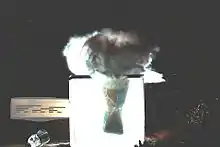Dry ice bomb
A dry ice bomb is a simple explosive device. While its simplicity, ease of construction, high bursting pressure and sound make it appealing for recreational purposes, it can be unpredictable and dangerous, and it has led to many injuries. Dry ice bombs are illegal in many jurisdictions.

Overview
Dry ice bombs are commonly made from a container such as a plastic bottle, water and dry ice. The bottle is filled about one quarter full of water. Chunks of dry ice are added and the container is to be shut tightly. As the solid carbon dioxide warms, it sublimates to gas. With limited room for the gas to expand, the pressure in the bottle increases. Bombs typically rupture within 30 seconds to 30 minutes, dependent largely on the temperature of the air outside the bottle.[1] A dry ice bomb may develop frost on its exterior prior to explosion.[1] After explosion, it appears to have shattered, with the overall shape of the device intact.[1]
Dangers
Dry ice bombs may induce serious risks:
- Explosion can occur within seconds, injuring the handler.
- The shockwave can be extremely loud, causing hearing damage even at substantial distances.
- The blast can propel fragments of the container at very high speeds, causing cuts and puncture wounds.
Injuries are common, with glass bottles in particular posing risks of serious injury or death.[2][3][4][5]
Bombs that fail to explode pose a major safety problem: They cannot be left, yet cannot be safely approached.
Legality
Dry ice bombs are illegal in many jurisdictions,[6][7] and can lead to imprisonment.[8]
- A law in California that defines "destructive device" includes a list of "weapons" including "[any] sealed device containing dry ice (CO2) or other chemically reactive substances assembled for the purpose of causing an explosion by a chemical reaction".[9][10]
- In Nebraska[11] and in other areas the noise generated may violate local laws.
- Arizona prohibits dry ice bombs if there is an intent to cause injury, death, or damage to the property of another,[12] as well as their possession by "prohibited possessors" such as convicted felons and illegal immigrants.[13]
- In Utah simple possession of a dry ice bomb or similar pressurized chemical reaction bombs is a second-degree felony.[14]
- In Colorado, the creation of a dry ice bomb is considered illegal due to interpretation as "possession of an explosive device"
- Leaving an unexploded dry ice bomb can be construed as public endangerment.
- Exploding a dry ice bomb in the state of Pennsylvania in public can result in criminal charges, if it is not done in an open area such as a bomb range or gun range.
In popular culture
- A dry ice bomb was featured on MythBusters, in episode 57 Mentos and Soda, which was first aired on August 9, 2006, and again in the "Don't Try This At Home" Special, which also demonstrated bending of a metal frame and serious damage to dummy rubber/bone forearms.
- An episode of Discovery channel's Time Warp features several dry ice bombs filmed on high speed camera; one on a tabletop and three in a metal tank with a transparent front. The cast believed that once one of the three bombs exploded, it would blow up the other two bombs; the first bomb exploded, rupturing the tank without exploding the other two 2-liter bottle bombs, and the cast and crew had to run and seek cover.
- In the game, Nine Hours, Nine Persons, Nine Doors, the main characters use a dry ice bomb to escape a freezer.
References
- Jill Meryl Levy (2006). The First Responder's Field Guide to Hazmat and Terrorism Emergency Response. Firebelle Productions. pp. 8–10.
- "NewsLibrary Search Results".
- "NewsLibrary Search Results".
- "Glass shrapnel injuries to children resulting from...[J Pediatr Surg. 1990] - PubMed Result". Ncbi.nlm.nih.gov. 2009-07-01. Retrieved 2009-09-20.
- "Toxicological Reviews — userLogin". Pt.wkhealth.com. Retrieved 2009-09-20.
- "Charlotte: Search Results". 2006-10-24.
- "> News > North County — Neighbors' long quarrel erupted". SignOnSanDiego.com. 2002-09-05. Retrieved 2009-09-20.
- "Dry-ice bomb prank ends in jail". The Press. May 2, 2008. Retrieved September 29, 2011.
- although dry-ice bombs rely upon the principle of phase-change, not chemical reaction
- "CA Codes (pen:12301-12316)". Leginfo.ca.gov. Archived from the original on 2009-05-13. Retrieved 2009-09-20.
- "State of Nebraska" (PDF). Archived from the original (PDF) on 2010-05-27. Retrieved 2009-09-20.
- "13-3102 – Misconduct involving weapons". Azleg.state.az.us. Retrieved 2009-11-10.
- "13-3101 – Definitions". Azleg.state.az.us. Retrieved 2009-09-20.
- "Bomb squad demonstrates dangers of homemade explosives", KSL.com.